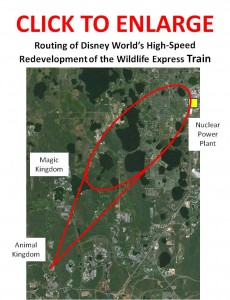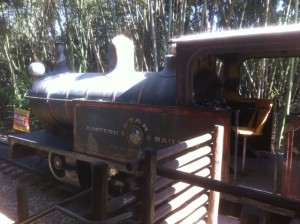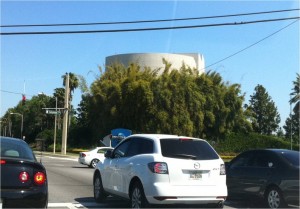Disney’s Next Generation Project to Include Partial Conversion of the Wildlife Express Train to High-Speed Rail, Continued
By Dave Shute
(This is the second page of this two-page April 1 article. For the first page, click here.)
THE ROUTE OF THE NEW NEXTGEN HIGH SPEED RAIL AT WALT DISNEY WORLD
To meet its performance potential, high-speed rail requires some specific infrastructure.
Details include a dedicated right of way; sufficient length to accelerate to top speeds and decelerate at station stops; broad, sweeping curves that start with a large radius and gradually decrease it (that is, spiral curves); and substantial electric power.
The Wildlife Express Train currently operates as a one way loop with two stations. The portion of the loop that gets guests from the rest of Disney’s Animal Kingdom to Rafiki’s Planet Watch will remain unchanged, as no one is in a hurry to get there.
The high speed component will replace the part of the loop that currently gets guests out of Rafiki’s Planet Watch.
The need for length to accelerate means that the routing will extend well out of Walt Disney World; it also means that a large curve will be required to get the trains back onto the property.

The Animal Kingdom is at the lower left, below the label.
The outbound leg of the high speed rail departs Rafiki’s Planet Watch, passes north of Epcot and the Port Orleans Riverside resort, leaves the property, and begins its sweeping curve in the Kirkland Road area.
The return leg re-enters Disney World on the northeast side of Bay Lake, cuts through the abandoned River Country water park, heads south of the Wilderness Lodge, and completes its journey in the Harambe station in the Africa section of the Animal Kingdom.
The second curve in the image–the one near Bay Lake that completes the oval–is not well understood.
Some think it exists to provide a continuous running option to increase travel time so that those taking the red-eye out of Rafiki’s Planet Watch can catch up on more of their sleep. Others suspect weak powerpoint skills.
My guess, however, is that it’s part of a future branch line that will open up the north and east shores of Bay Lake to future Walt Disney World resort hotel development, perhaps linking new deluxe resorts to the Animal Kingdom, to the Wilderness Lodge and to cheap beer at the Hess store south of the Magic Kingdom.
The train will require substantial new electrical power to operate. (Only electric power can provide the instantly available starting torque required for the levels of acceleration that high speed rail entails.)
To meet this need, current plans are for Disney to build a new nuclear-powered electrical generating station. This station will support not only the new high-speed railway, but also the electrification of the portion of the track that will be left unchanged. Excess electrical capacity will add burst power to the Tiki birds.

This is in keeping with the green theme at the Animal Kingdom.
Many know that the peculiar legislative circumstances attending Walt Disney World’s creation resulted in Disney gaining almost all the powers of municipalities and counties, and all the powers of a Chapter 298 improvement district.
These negotiations, supported on Disney’s side by among others “Wild Bill” Donovan, former head of the OSS, and on the State of Florida side by Elmer Fudd and Mr. Magoo, preserved to the state a few key rights in which it had a fundamental interest, such as the right to inspect elevators, but yielded to Disney almost all other powers, and added to them the rights for Disney to build an airport and a nuclear power plant.
Less well known is that the improvement district status also granted Disney limited powers of eminent domain off of its own property. (Among the limits are that any use of eminent domain must also enhance the Tiki birds.)
Disney World will use these eminent domain powers both to assemble the off-property part of the right of way for the high-speed train, and to gain a site for its new nuclear reactor.
Extensive studies of the local geology–which, like most of central Florida, comprises reptiles in swamps on decaying vegetative matter on top of buckets of macaroni, except limestone, with escaped pet pythons livening up the food chain–have indicated that there’s only one optimum spot near the route for the reactor to be built.
This planned reactor location is about a mile and a half north of Sand Lake Road, just to the east of the intersection of Turkey Lake Road and Panther Way.

However, Disney’s powers of eminent domain will let it freely acquire the current property, raze it, and replace it with a nuclear power plant.
Moreover, parts of the existing improvements to the property could be re-used as a reactor containment building. See the image above.
The disaster in Japan (God bless you all…) has led to alternative power supply plans being developed. The current alternative plan is a manure gasification power plant. Bio-reactors would convert manure to methane. The methane would be burned to heat water, creating steam to spin the electrical generators.
This approach would be consistent with the overall green approach, and would build on Central Florida’s history as a cattle and equestrian center, as well as leveraging supply from the Animal Kingdom and Tri-Circle D ranch. Any insufficiency in supply would be met by cow manure trucked in from Columbus, Ohio.
The location of the manure gasification plant would be the same as that identified for the nuclear plant, because of appropriate groundwater structures and other factors. A Disney spokesman in attractive Swedish footwear noted that he “couldn’t think of a better spot in Central Florida for manure settling tanks.”



0 comments
Comment by typing in the form below.
Leave a Comment | Ask a Question | Note a Problem